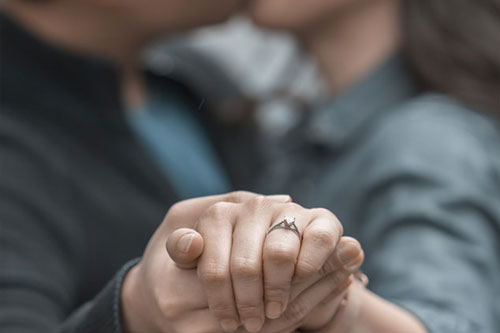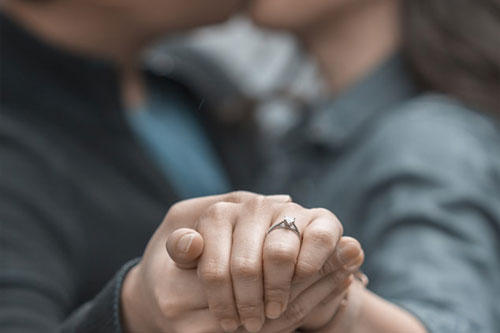BUYING-GUIDES

10 Ways To Make Your Diamond Look Bigger
The size of the diamond is the first thing that most people notice when looking at a diamond engagement ring, so it’s natural to want a bigger stone that is just as impressive as the style of the ring itself. But, what if there was a way to make the diamond look bigger without spending a small fortune? If big on a budget is what you’re after, then read on as we share our 10 WAYS TO MAKE YOUR DIAMOND LOOK BIGGER, without breaking the bank!
Lots of people make the mistake of focusing on the carat weight of the focal diamond as an indicator of its size but this can be a mistake in some cases. If a larger center diamond is not feasible in your budget, there are other ways to maximize size:
1. Get the right cut
Nothing determines the overall appearance of beauty and size than the cut of the diamond. Regardless of its actual carat weight, a perfectly cut diamond reflects light at the optimum angles to give the stone natural radiancy and sparkle – while also adding to the visual dimension of the diamond itself. But, how can you tell if the diamond is well cut? Well, if the diamond is round cut (which is often the popular choice for most cuts), only consider a stone with a GIA certified ‘excellent’ cut grade. Unfortunately for other shapes, there isn’t a cut grade so it’s best to seek advice from our experienced team of jewellers in Hatton Garden to ensure that whatever shape you pick, it is perfectly cut.
2. Consider other shapes
Although round is the most popular choice for diamond engagement rings, they are also the most expensive in terms of their carat weight. However, there are alternative shapes that can make your stone look larger and also offer more carats in return. Diamonds that are elongated, like the Oval, Emerald, Pear, Radiant and even the Marquise (commonly considered for the more dainty engagement ring), appear larger than they are because they take up more space on your finger, and hence, look visibly more significant than their actual carat weight.
3. Make it a Halo
By choosing a halo engagement ring to frame the centre stone, you can introduce a circle of smaller (less expensive) round brilliant diamonds to encapsulate the larger diamond and give the illusion of a bigger overall diamond ring. This adds more dimension, sparkle and impact to the ring to make the diamond look bigger than it is.
4. Pavé the way to your diamond
A pavé setting is a type of engagement ring where the band of the ring is lined with small diamonds. These diamonds are held in place with barely visible metal prongs or beads to create the appearance of a line of continuous small diamonds. This setting adds extra sparkle to the engagement ring, while at the same time, emphasizing the beauty of the center diamond.
5. When one won’t do, go for Three!
Traditionally symbolising friendship, love, and fidelity, a Three Stone Ring is the perfect choice for romantic couples who want their engagement story to be encapsulated with the same meaning that is unique to their own relationship. The Three Stone style features two smaller diamond accent stones that embrace the larger center stone. This way, you can spread the cost and total carat weight across three diamonds, giving you a knockout center stone, and complementary smaller stones, so you get triple the sparkle and a fuller dimension.
6. Opt for delicately bigger
Opting for a dainty engagement ring with a slender band is a great option for anyone looking for a more effortless style that is simple, understated and elegant, while still giving the impression that the diamond is bigger than it actually is. A Marquise Cut Engagement Ring with a pavé setting draws the attention to the centre stone for a dainty engagement ring that also has beautiful detailing and sparkle.
7. Consider a lab grown diamond ring
A lab grown diamond engagement ring is not only the ethical and responsible choice, it’s become a popular alternative for couples that desire a bigger stone at a lower price point. There is no difference between a man-mined diamond and a diamond created in a lab – they are identical in the optical, physical and chemical compositions in every way. However, a lab grown diamond engagement ring can work out to be up to 40% cheaper than a natural diamond ring making it a great way to upsize without spending a fortune.
8. Look at a diamond alternative and add some colour
If you want to break free from a traditional diamond engagement ring, you may want to choose a beautiful coloured gemstone instead. Popular with celebrities like Victoria Beckham, Kate Middleton, Elizabeth Olsen and Olivia Wilde, the gemstone captures an individual’s personality which is why it is still a firm favourite today. Moissanite – a rare and scarce mineral that is man-made was introduced to the jewellery market in 1998. This stone reflects light perfectly, closely rivaling the natural brilliance of the diamond. Sapphires are another great choice. They are the most durable gemstones after diamonds and are available in various colours, including white, so it’s another great alternative.
9. Add fewer and slender prongs
A clever way to make your centre stone appear larger is to minimise anything else that surrounds it. By opting for discreet or slender prongs, you’ll see more of the diamond’s surface rather than the prongs. In addition, by going for fewer prongs, you will help the eye remain focused on the diamond itself rather than the four, five or six prongs that are commonly used for a round cut diamond, for example.
10. Keep up with regular cleaning
A regular professional clean (every 6 months or so) will keep your diamond polished and free from any debris so it continues to sparkle. In between the professional clean, use a jewellery cleaner, polishing cloth or, a few drops of washing up liquid and warm water will also do the trick. Let the ring air dry or use a lint-free cloth to remove any excess oils like lotion or makeup. Your engagement or wedding rings need to shine forever.
This will ensure your diamond continues to be an eye-catching feature every time.
More information
For more help and advice on how to maximise the appearance of size for your diamond, get in touch with our experienced team of jewellers in Hatton Garden at Flawless Fine Jewellery. With an extensive selection of diamonds and gemstones like sapphire featuring different shapes and sizes, we have the carat to suit every preference in raw and synthetic lab grown diamonds.
Click here to view the range or get in touch for more information.

Previous Article
Fun Facts about Lab Grown Diamonds
Next Article
From Ancient Rome to Lab Grown - the evolution of the ethical engagement ring





